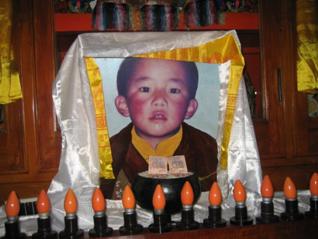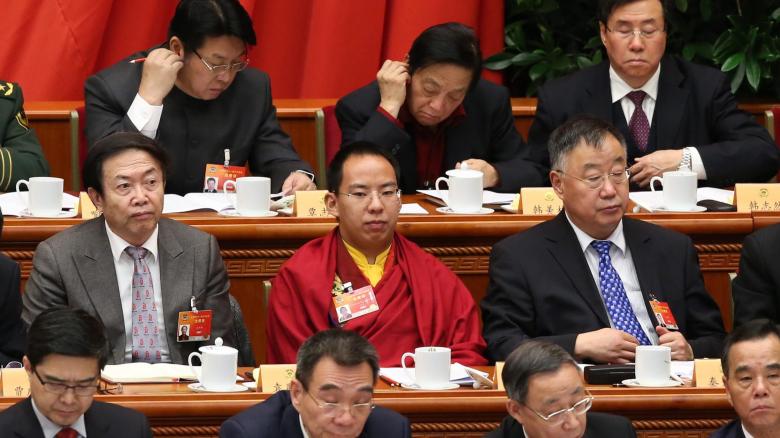Authorities in China are setting up a database of legitimised Buddhist Rinpoches in China, to be released to the public online, reports China Tibet Online. They added that their intention was to help Buddhist followers to distinguish between real and fake lamas or tulkus.
“Some fake Rinpoches have posed threats to national security, as they use money they collect to sponsor illegal or even separatist activities in Tibet” said Zhu Weiqun, Chairman of the Ethic and Religious Committee of the Chinese People’s Political Consultative Conference in an interview with China Central Television (CCTV), as he called on local authorities to take action against these “fake Rinpoches”.
According to Zhu, fake Rinpoches or tulkus are the ones who support activities in Tibet. The Global Times has reported that Wang Xiaobin and Lhamo, scholars with the Beijing-based China Tibetology Research Centre, have said that in order to be a reincarnation of a Rinpoche or tulku, a monk has to go through a confirmation process involving religious rituals, traditional conventions and government approval.
Despite this announcement, the Chinese government has denounced Gedun Choekyi Nyima who was recognised as the reincarnation of the 10th Panchen Lama by the Dalai Lama following the traditional and religious procedure of appointing a reincarnation. The Chinese government abducted Genden Choekyi Nyima at the age of six and his whereabouts are still not known, although in September this year a member of the Tibet Autonomous Region’s United Work Front Department said that Gedun Choekyi Nyima is living a normal life and does not wish to be disturbed. In his place, the Chinese government selected and appointed Gyaltsen Norbu as the reincarnation of the 10thPanchen Lama. Norbu is spurned by many Tibetans who do not recognise him as the Chinese Panchen Lama.
These issues have hit the news as this month Chen Quanguo, the party secretary of Tibet, has urged Gyaltsen Norbu, the “Chinese Panchen Lama” to publicly shun the 80-year-old exiled Tibetan spiritual leader, the Dalai Lama, who is the highest figure in Tibetan Buddhism. “Resolutely draw a clear line between the 14th Dalai Lama and firmly reject all subversive separatist activities,” Chen told Gyaltsen Norbu during a meeting to mark 20 years since the latter’s appointment.
The ongoing dispute between the Chinese government and the 14th Dalai Lama over who has the right to name the next Dalai Lama may strike many as baffling. The Chinese government sees His Holiness the Dalai Lama as a “separatist” who has immense followers and has never given up on campaigning for Tibet’s independence, and therefore a threat to Chinese national integrity.
On November 30, China reiterated their stance on the matter by saying that they will never give up the right to decide on the Dalai Lama’s reincarnation. The Dalai Lama was the first political leader of Tibet, and Zhu Weiqun, a member of Communist Party and chairman of the ethnics and religious affairs committee was reported in the state-run Global Times as saying, “whoever has the name of Dalai Lama will control political power in Tibet”. It is clear that Beijing sees the appointment of the next Dalai Lama as the key to consolidating state control over Tibet, where protests and campaigns against their rule have continued since China invaded Tibet in the 1950s.
The “Beijing authorities or the atheist communist party of China have neither legitimacy nor credibility on this matter,” Lobsang Sangay, the democratically elected political leader of the Tibetan Government-in-exile based in Dharamshala, told Reuters.
Tibetans fear that China will use the issue of the Dalai Lama’s succession to split Tibetans; they see the possibility of two Dalai Lamas, one chosen by the Chinese government and one by exile Tibetans. His Holiness the Dalai Lama has said that the decision whether or not to have another Dalai Lama depends on the Tibetan people and he will leave it up to them to decide. He has also hinted that his role could end with his passing.
The Dalai Lama – the Tibetan spiritual leader – has been residing in his exile home at Dharamshala, Himachal Pradesh in north India since he fled China’s occupation in 1959 at the age of 23. Despite the exile Tibetan government and international human right groups calling for religious freedom in Tibet, China has so far paid no heed and their harsh policies continue in Tibet.






 Print
Print Email
Email